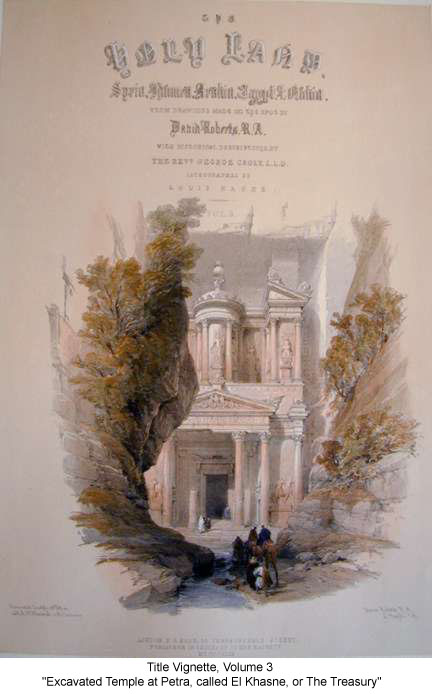


In Roberts' day few persons journeyed much beyond their home town. Travel was difficult, slow and expensive. With photography just in its infancy, printed books of landscape and travel drawings were for most people their only window to the outside world.
Prior to the 1840's, the available engraving and etching techniques permitted the production of only small editions of illustrated books on travel or nature, usually limited to a few hundred pressings before the soft metal engraving plates deteriorated. The subtleties of the artist's tone and line were for the most part lost in the production process, and the resulting black and white images were often lacking when compared to the original artworks.
Color was applied by hand painting the printed illustrations, and with a combination of complex engraving techniques and hand coloring, impressive results could be obtained, though at relatively great cost. For example, between 1820 and 1840 the renowned folio editions of Pierre Joseph Redouté's Les Roses and John James Audubon's Birds of America were produced using the stipple engraving and aquatint processes, respectively, and then laboriously hand colored.
Lithography, a fundamentally new printing process, was invented in Germany in 1798 and by the 1820's was coming into use in England and America. It differed from engraving in that the image to be printed was drawn on stone with a greasy crayon, rather than cut into a metal engraving plate. Ink adhered to the greasy areas and was transferred more readily to the paper than with engraving. This allowed for a more natural print drawing technique which could produce line values and shadings much closer to the original work, particularly as to pencil and watercolor art. Soon lithographers were adding a second pressing of the same image using another stone with a different ink color, often tan or fawn, to produce a more varied and realistic result. This became known as "tintstone lithography", and by the 1840's a third stone was being used to add blues, greens or other tints. Thus the technique of "double tintstone lithography" had been born.
The process was still extremely time consuming, and for high quality works full coloring was still added by hand. The results were by far the best yet seen, however, and the period from about 1840 to 1860 became known as the "Golden Age" of tintstone lithography. By 1870, however, the much more economical process of photography began to spread (for example, Matthew Brady's images of the United States Civil War) and to displace tintstone lithography for works on nature and travel. The Golden Age of tinstone lithography had ended, and the process has since become a medium primarily for the production of high quality, limited edition, signed artwork.
The First Edition lithographs of David Roberts' drawings and paintings of his travels in Egypt and the Holy Land were produced at the very peak of this Golden Age, and are widely acknowledged to be perhaps the finest double tintstone lithographs ever made. Roberts' pencil drawing and watercolor technique lent itself perfectly to the medium, and he experienced the almost incredible good fortune of finding a publisher, F.G. Moon, who would produce the prints in the huge and expensive folio format, and who would in turn engage the Belgian lithographer Louis Haghe to craft the stones. Haghe, perhaps history's most talented lithographer, was an artist in his own right whose personal style meshed almost perfectly with Roberts'. The happy results were what are known to collectors today simply as "Roberts Prints". The best of these images stand on a level, in quality and value, with the folio editions of Audubon and Redouté mentioned above. There really is nothing else quite like them - a stunningly beautiful record of a romantic journey in a time gone by.